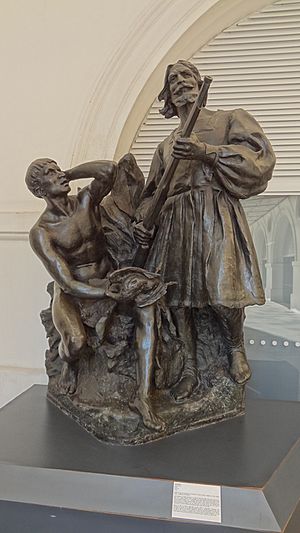Caramuru facts for kids
Quick facts for kids
Caramuru
|
|
|---|---|

Sculpture by Eduardo de Sá
|
|
| Born |
Diogo Álvares Correia
c. 1475 Viana do Castelo, Portugal
|
| Died | 5 October 1557 |
| Nationality | Portuguese |
| Occupation | Explorer and settler |
| Spouse(s) | Catarina Paraguaçu |
Caramuru (around 1475-1557) was the name given by the Tupi people to a Portuguese explorer named Diogo Álvares Correia. He was the first European to meet the native Tupinambá people in what is now Brazil. Caramuru played a very important role in helping Portugal start its colony in Brazil. His wife, Catarina Paraguaçu, was a native Brazilian. She was even the first South American native person to visit the Palace of Versailles in France in 1526! Caramuru and Catarina became the first Christian family in Brazil. They had three sons who later became knights.
His Amazing Journey
Diogo Álvares Correia was born in Viana do Castelo, Portugal. He left for the Portuguese colony of Brazil around 1509. He was probably on a French ship. His ship was wrecked, likely near the reefs of Rio Vermelho. Correia found himself alone among the Tupinambá Indians. They called him "Caramuru", which means "Moray". Correia married Paraguaçu, who was the daughter of Chief Taparica.
For the next twenty years, Caramuru stayed in touch with European ships. He used his influence with the local Indians to help the Portuguese. He also helped missionaries during the early years of Brazil's colonization. In 1526, he traveled to France with his wife. Paraguaçu was baptized and given the name Katherine du Brézil. This made them the first Brazilian Christian family.
A few years later, King João III of Portugal asked him to return to Bahia. In 1534, Caramuru helped Francisco Pereira Coutinho. Coutinho was the first captain of Bahia. They worked to set up the settlement of Pereira. This place is now known as Vila Velha in modern Salvador.
By 1546, Pereira Coutinho had upset the Tupinambá people. He had treated them badly, and they became hostile. Caramuru followed him when he fled to Porto Seguro. Caramuru wanted to calm the situation. When they returned the next year, their ship was damaged. The Tupinambá captured the survivors. Caramuru was spared, but the captain was killed by the Tupinambá. In 1549, Caramuru helped Tomé de Sousa found Salvador. This city became the first main government center for the entire Brazilian colony.
Family and Legacy
Caramuru passed away in October 1557. He was buried in the Church of Jesus. He left half of his money to the Jesuits. His wife, Catarina Paraguaçu, died in 1582. Their sons, Gaspar, Gabriel, and Jorge, were declared knights. This was for their help to the Portuguese Crown. They later helped found Cachoeira on the Paraguaçu.
Caramuru in Stories
- A famous epic poem about Caramuru was written by Santa Rita Durão. It is called Caramuru.
- Caramuru was played by Selton Mello in the 2001 movie Caramuru: A Invenção do Brasil. This movie was based on the poem.
- Caramuru also appears briefly in Mário de Andrade's 1928 novel, Macunaíma.
- He is the main character in Emilio Salgari's adventure novel "L'uomo di fuoco" (1904). This book has been translated into many languages.
See also
 In Spanish: Diogo Álvares Corrêa para niños
In Spanish: Diogo Álvares Corrêa para niños

